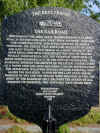History of Williston
Descendants of an early settler named Robert Willis founded the town of
Williston in the early nineteenth century. Growth occurred rapidly following the
establishment of a railroad running from Charleston to Augusta. On Christmas
Day, 1833 the locomotive "Best Friend" made the first trip along the
136 mile route, averaging 12 miles per hour! At the time the longest railroad in
the world, by the 1840s over 100,000 bales of cotton a year were being shipped
along it to Charleston. Farms soon sprung up along the route, and Williston soon
became an important station stop.
along the
136 mile route, averaging 12 miles per hour! At the time the longest railroad in
the world, by the 1840s over 100,000 bales of cotton a year were being shipped
along it to Charleston. Farms soon sprung up along the route, and Williston soon
became an important station stop.
During the Civil War Union forces under Sherman made a concerted effort to
cut and then destroy the rail line, which was an important supply route from the
interior to Charleston. On February 8, 1865, Major-General Kilpatrick, the
commander of the Union Cavalry, reached Williston. He set up a headquarters in
the Ashley-Chapman house and, pushing on, fought a sharp skirmish with
Confederate forces guarding the rail line two miles west of the center of town
near White Pond. Units of the First Alabama Cavalry were badly routed and a
number of battle flags captured.
and, pushing on, fought a sharp skirmish with
Confederate forces guarding the rail line two miles west of the center of town
near White Pond. Units of the First Alabama Cavalry were badly routed and a
number of battle flags captured.
Over the next several daysí successive Union forces moved into and through
Williston on their way to Columbia, tearing up the railroad ties and track in
their wake. Much of the town was burned as they left, with only the
Ashley-Chapman house and a nearby house where a woman had just given birth were
spared. Shermanís comments on the matter were "we donít burn occupied
houses, but if people vacate their own houses I donít think they should expect
us to protect them." Kilpatrick is reputed to have said that when he got
through, Barnwell County would have to be renamed "Burn Well". Many
honored dead from the war are buried in the town cemetery.
Major rebuilding occurred in the years during and following Reconstruction,
as farming came back, and many of the homes around the town date from this
period. IN the early twentieth century it was discovered that local conditions
were ideal for asparagus, and until the early 1930s more asparagus was grown and
shipped from the Williston area than from any other part of the country, earning
the town the nickname "The Asparagus Capitol of the World."
Unfortunately, California gradually captured the market, and only now are
asparagus crops being established locally.
The first phone system in Williston was established in 1905 and had ten
subscribers. City waterlines were built in 1917, and electric power was
established in 1919 (at first only available from 5 PM to midnight). The high
school built in 1925 and now housing administrative offices, is one of the
oldest buildings of its kind in the state.
Home to a number of large and small businesses, beautiful homes and gardens,
pleasant people, and tranquil neighborhoods, Williston is a quiet, peaceful
town.
(From the Historic Williston South Carolina brochure)
Other items of interest related to Williston history:


Ashley-Chapman House Plaque
Railroad Remembrance Plaque
 The
railroad depot continued to be the center of activity. It was a place to chat,
learn the latest news, transact business, and watch the rain go by. The second
depot was erected in 1912, but was destroyed by a fire that originated on the
loading platform March 12,
The
railroad depot continued to be the center of activity. It was a place to chat,
learn the latest news, transact business, and watch the rain go by. The second
depot was erected in 1912, but was destroyed by a fire that originated on the
loading platform March 12, 1946. Not only was the depot destroyed but a large portion of the town was
burned.
1946. Not only was the depot destroyed but a large portion of the town was
burned.
 On
July 13, 1995, a fire started in the downtown area devastating several buildings
and the damage it caused to the structures was estimated over $1 million
dollars.
On
July 13, 1995, a fire started in the downtown area devastating several buildings
and the damage it caused to the structures was estimated over $1 million
dollars.
